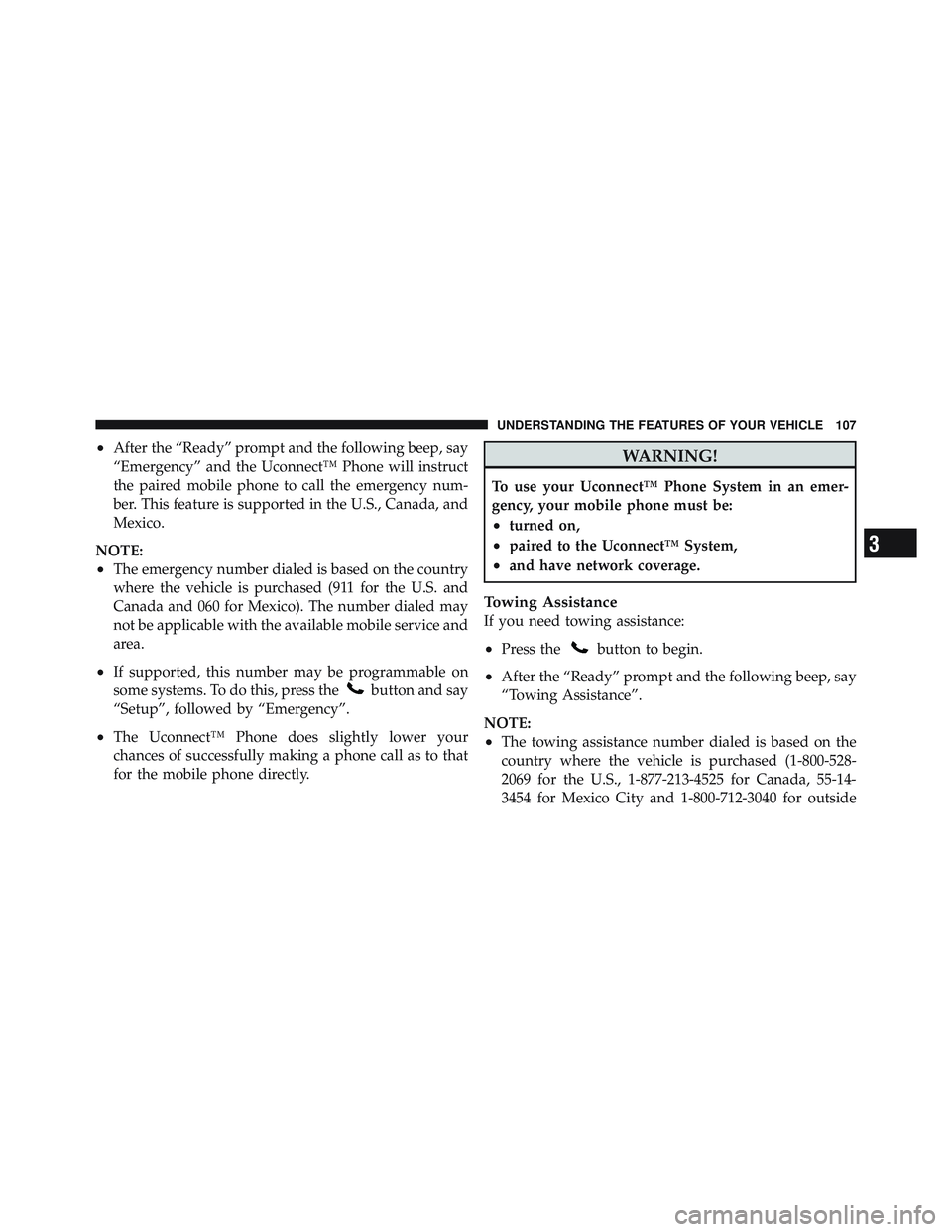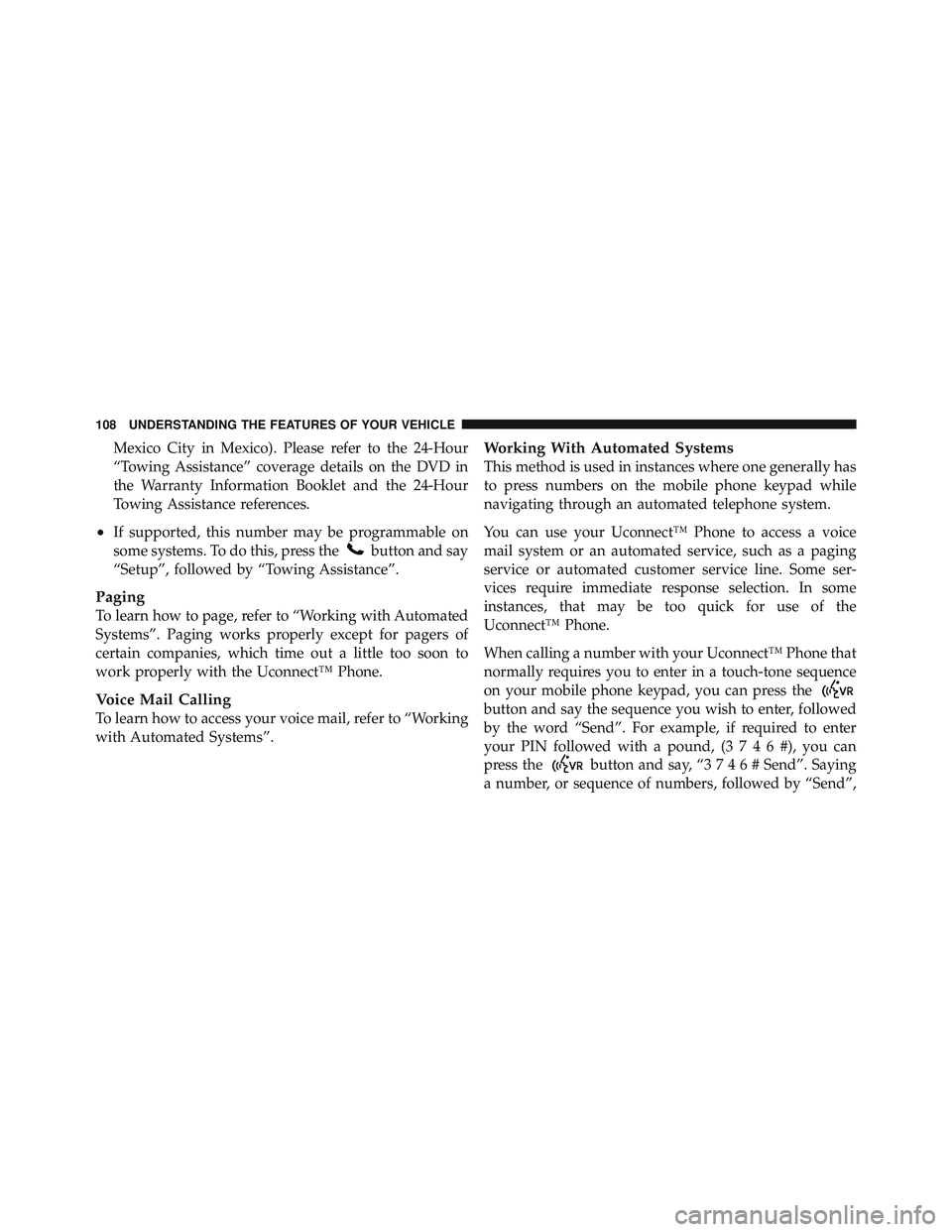Page 85 of 502
UNDERSTANDING THE FEATURES OF YOUR VEHICLE CONTENTS � Mirrors .............................. 87
▫ Inside Day/Night Mirror ................ 87
▫ Automatic Dimming Mirror — If Equipped . . . 87
▫ Outside Mirrors ...................... 88
▫ Outside Mirrors Folding Feature .......... 89
▫ Power Mirrors — If Equipped ............ 90
▫ Heated Mirrors — If Equipped ............ 91
▫ Illuminated Vanity Mirror — If Equipped .... 91 ▫ “Slide-On-Rod” Features Of Sun Visor — If
Equipped ........................... 92
▫ Trailer Towing Mirrors — If Equipped ...... 92
� Uconnect™ Phone — If Equipped ........... 93
▫ Operation .......................... 96
▫ Phone Call Features .................. 103
▫ Uconnect™ Phone Features ............. 106
▫ Advanced Phone Connectivity ............111
▫ Things You Should Know About Your
Uconnect™ Phone .................... 1123
Page 94 of 502
“Slide-On-Rod” Features Of Sun Visor — If
Equipped
The sun visor “Slide-On-Rod” feature allows for addi-
tional flexibility in positioning the visor to block out the
sun.
To use the “Slide-On-Rod” feature, rotate the sun visor
downward and unclip it. Pull the sun visor along the
“Slide-On-Rod” until the sun visor is in the desired
position.
Trailer Towing Mirrors — If Equipped
These mirrors are designed with an adjustable mirror
head to provide a greater vision range when towing
extra-wide loads. To change position inboard or out-
board, the mirror head should be rotated (flipped in or
out). Slide-On-Rod Extender92 UNDERSTANDING THE FEATURES OF YOUR VEHICLE
Page 95 of 502
NOTE: Fold the trailer towing mirrors rearward prior to
entering an automated car wash.
A small blindspot mirror is located next to main mirror
and can be adjusted separately. Uconnect™ Phone — IF EQUIPPED
Uconnect™ Phone is a voice-activated, hands-free, in-
vehicle communications system. Uconnect™ Phone al-
lows you to dial a phone number with your mobile
phone using simple voice commands (e.g., “Call” �
“Mike” � “Work” or “Dial” � “248-555-1212”). YourTrailer Towing Position Blindspot Mirror
3 UNDERSTANDING THE FEATURES OF YOUR VEHICLE 93
Page 109 of 502

• After the “Ready” prompt and the following beep, say
“Emergency” and the Uconnect™ Phone will instruct
the paired mobile phone to call the emergency num-
ber. This feature is supported in the U.S., Canada, and
Mexico.
NOTE:
• The emergency number dialed is based on the country
where the vehicle is purchased (911 for the U.S. and
Canada and 060 for Mexico). The number dialed may
not be applicable with the available mobile service and
area.
• If supported, this number may be programmable on
some systems. To do this, press the button and say
“Setup”, followed by “Emergency”.
• The Uconnect™ Phone does slightly lower your
chances of successfully making a phone call as to that
for the mobile phone directly. WARNING!To use your Uconnect™ Phone System in an emer-
gency, your mobile phone must be:
• turned on,
• paired to the Uconnect™ System,
• and have network coverage.
Towing Assistance
If you need towing assistance:
• Press the button to begin.
• After the “Ready” prompt and the following beep, say
“Towing Assistance”.
NOTE:
• The towing assistance number dialed is based on the
country where the vehicle is purchased (1-800-528-
2069 for the U.S., 1-877-213-4525 for Canada, 55-14-
3454 for Mexico City and 1-800-712-3040 for outside 3 UNDERSTANDING THE FEATURES OF YOUR VEHICLE 107
Page 110 of 502

Mexico City in Mexico). Please refer to the 24-Hour
“Towing Assistance” coverage details on the DVD in
the Warranty Information Booklet and the 24-Hour
Towing Assistance references.
• If supported, this number may be programmable on
some systems. To do this, press the button and say
“Setup”, followed by “Towing Assistance”.
Paging
To learn how to page, refer to “Working with Automated
Systems”. Paging works properly except for pagers of
certain companies, which time out a little too soon to
work properly with the Uconnect™ Phone.
Voice Mail Calling
To learn how to access your voice mail, refer to “Working
with Automated Systems”. Working With Automated Systems
This method is used in instances where one generally has
to press numbers on the mobile phone keypad while
navigating through an automated telephone system.
You can use your Uconnect™ Phone to access a voice
mail system or an automated service, such as a paging
service or automated customer service line. Some ser-
vices require immediate response selection. In some
instances, that may be too quick for use of the
Uconnect™ Phone.
When calling a number with your Uconnect™ Phone that
normally requires you to enter in a touch-tone sequence
on your mobile phone keypad, you can press the
button and say the sequence you wish to enter, followed
by the word “Send”. For example, if required to enter
your PIN followed with a pound, ( 3746#),youcan
press the button and say, “ 3746# Send”. Saying
a number, or sequence of numbers, followed by “Send”,108 UNDERSTANDING THE FEATURES OF YOUR VEHICLE
Page 124 of 502
Voice Commands
Primary Alternate(s)
language
list names
list phones
mobile
mute
mute off
new entry
no
other
pair a phone
phone pairing pairing
phonebook phone book
previous
record again
redial Voice Commands
Primary Alternate(s)
return to main menu return or main menu
select phone select
send
set up phone settings or phone
set up
towing assistance
transfer call
Uconnect™ Tutorial
try again
voice training
work
yes122 UNDERSTANDING THE FEATURES OF YOUR VEHICLE
Page 191 of 502

INSTRUMENT CLUSTER DESCRIPTIONS
1. Tachometer
The Tachometer indicates engine speed in revolutions per
minute (RPM x 1000).
CAUTION!Do not operate the engine with the tachometer
pointer at high RPM for extended periods. Engine
damage may occur.
2. Turn Signal Indicators
The arrow will flash with the exterior turn signal
when the turn signal lever is operated.
NOTE:
• A continuous chime will sound if the vehicle is driven
more than 1 mile (1.6 km) with either turn signal on. • Check for an inoperative outside light bulb if either
indicator flashes at a rapid rate.
3. Fuel Gauge
Shows level of fuel in tank when ignition switch is in the
ON/RUN position.
4. Temperature Gauge
The temperature gauge shows engine coolant tempera-
ture. Any reading within the normal range indicates that
the engine cooling system is operating satisfactorily.
The gauge pointer will likely indicate a higher tempera-
ture when driving in hot weather, up mountain grades,
or when towing a trailer. It should not be allowed to
exceed the upper limits of the normal operating range.
4 UNDERSTANDING YOUR INSTRUMENT PANEL 189
Page 193 of 502

rotate at the same speed. Low range provides a greater
gear reduction ratio to provide increased torque at the
wheels.
7. Electronic Throttle Control (ETC) Light
This light informs you of a problem with the
Electronic Throttle Control (ETC) system. The
light will come on when the ignition is first
turned to ON/RUN and remain on briefly as a
bulb check. If the light does not come on during starting,
have the system checked by an authorized dealer.
If a problem is detected, the light will come on while the
engine is running. Cycle the ignition key when the
vehicle has completely stopped and the shift lever is
placed in the PARK position, the light should turn off.
If the light remains lit with the engine running, your
vehicle will usually be drivable; however, see an autho-
rized dealer for service as soon as possible. If the light is
flashing when the engine is running, immediate service is required and you may experience reduced performance,
an elevated/rough idle or engine stall and your vehicle
may require towing.
For vehicles equipped with a premium cluster this indi-
cator will display in the Electronic Vehicle Information
Center (EVIC). Refer to ”Electronic Vehicle Information
Center (EVIC) — If Equipped” for further information.
8. 4WD Indicator
This light indicates the vehicle is in four-wheel
drive and 4LOCK. 4WD allows all four wheels
to receive torque from the engine simultane-
ously.
9. SVC (Service) 4WD
The SVC 4WD light monitors the electric shift
four-wheel drive system. If the SVC 4WD light
stays on or comes on during driving, it means
that the four-wheel drive system is not func-
tioning properly and that service is required. 4 UNDERSTANDING YOUR INSTRUMENT PANEL 191